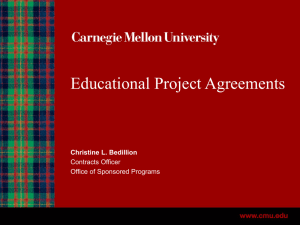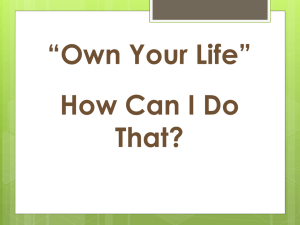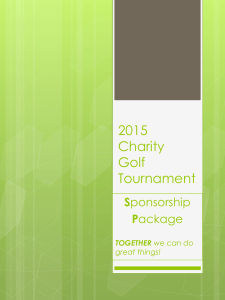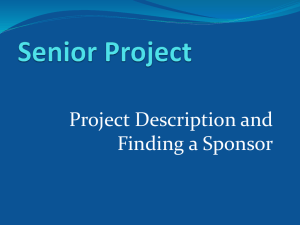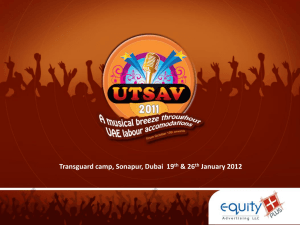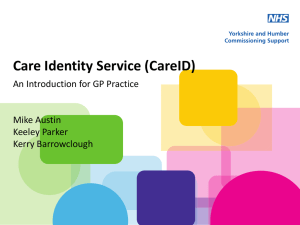The Actual Writing Part - CHASS - University of California, Riverside
advertisement
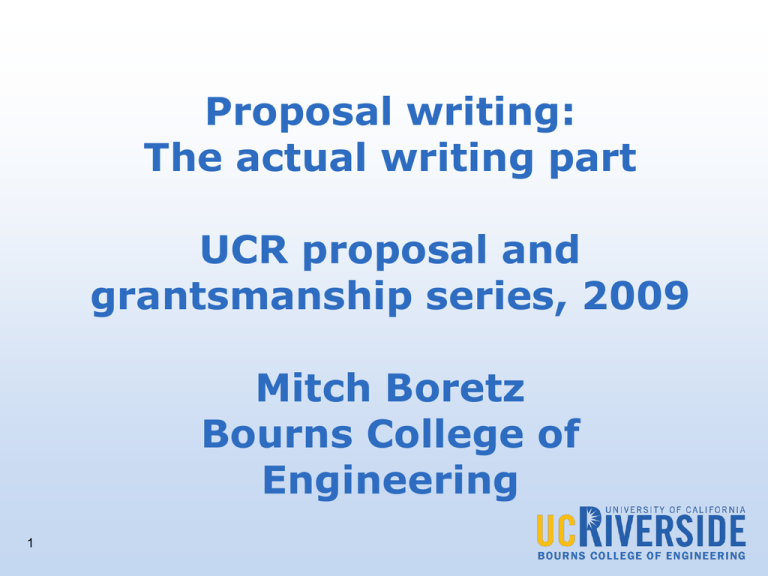
Proposal writing: The actual writing part UCR proposal and grantsmanship series, 2009 Mitch Boretz Bourns College of Engineering 1 2 Three easy steps • Figure out what you want to say. • Say it. • Shut up. 3 How to do that • Understand your audience. • Understand your constraints. • Formulate your message and stick to it. • Use words and graphics effectively. • Be consistent and professional. 4 What you want to say • The audience • What does the sponsor/customer want? What is important to the people making the funding decision? Why? • Science agencies vs. mission agencies vs. companies. • Grant (public benefit purpose) or contract (acquisition purpose) or Cooperative Agreement or Other Transaction or Marketing Board Order or Gift or what? 5 What you want to say • What you want to sell is not necessarily what the customer wants to buy. 6 What you want to say • What does the customer really want? • When someone buys a 3/8-inch drill, it’s not because he wants a 3/8-inch drill. It’s because he wants a 3/8inch hole. 7 What you want to say • Therefore, be sure you are selling what the buyer is buying. Write about what interests the sponsor/ customer, which may or may not be what interests you. 8 What you want to say • The constraints • If you only have 15 pages to tell your story, it’s probably not a good idea to write 75 pages and then figure out how to cut it down. • Outline: a detailed outline of the proposal, including space allocations. Map the sections of the proposal to the scoring criteria. • Storyboard. A mock-up of the proposal showing the points each section will make, the space allocated to each section’s text and graphics, etc. • Compliance matrix: an enhanced table of contents (if allowed) showing the reader where you address each evaluation criterion. 9 What you want to say • Telling the story with pictures • Use graphics! Ten years ago, color pictures in proposals were rare. Ten years from now, moving pictures will be common. • How do you know whether graphic material is adding enough value to deserve the space in your proposal? Courtesy of Dr. Stewart Moses,* Northrop-Grumman Corp., consider the following: • 10 * Moses, S. Counting Ferrets. Association of Proposal Management Professionals 2008 Proposal Tricks & Treats Conference, Anaheim, CA, October 24. See www.socal-apmp.org. What you want to say • Your graphic needs more content if... • The graphic is a Venn diagram. • The graphic has boxes with arrows pointing to every other box. • The graphic is a flow diagram with no discernible start or finish. • The graphic relies on making cute shapes out of words. • You can replace a key term in the graphic with “Toyota” and it still makes sense. 11 What you want to say • What makes you special? • Many of us live in a world of 10% win rates (on a good day). Our proposals must highlight what makes us special: • Why should the sponsor do what I propose? • Why do it now? • Why am I the best choice to do it? • If you can answer those three questions compellingly in the context of what the sponsor is looking for, you can win. 12 What you want to say • Win themes and differentiators • Make a list of the things that are special about your idea and approach. These are things important to the person making the funding decision – not necessarily the things important to you. (Remember the 3/8-inch hole.) • What will your competitors propose? How do you show that your approach is better (without insulting the competition or the peer reviewer)? 13 What you want to say • Win themes and differentiators • Put yourself into the reviewer’s shoes. The sponsor has to find a reason to say no to >90% of the proposals. What will be the reason to say no to yours? How do you anticipate and neutralize it? 14 What you want to say • What has worked before? • Review past wins and losses. • Often, if you just call a past winner, he/she will talk to you. (Excuse me, Dr. Smith, but please tell me why you’re so darn brilliant and successful...) • Government agencies must share winning proposals under the Freedom of Information Act. • You can learn as much (or more) from losses as from wins. • Always request a debriefing – either written reviewer comments or a conference call with the program officer – win or lose. 15 Ready to start writing? • Use Dr. Tom Sant’s NOSE paradigm. If you are prepared to address these four things, you’re ready. • Need: Do you understand what the customer/sponsor really wants? This may or may not be in the solicitation. • Outcomes: Can you convince the reviewers that you can deliver desired outcomes? • Solution: Can you define an approach that will give the customer confidence in selecting you? • Evidence: Can you substantiate the things you say? How will you back up your hypothesis? Your approach? Your promised outcomes? 16 Say it. 17 Say it • The summary: first or last? • Both. If you can’t say it in one page, you’re probably not ready to say it in 25 pages. So I recommend: • Write the summary first. • Write the proposal. • Come back to the summary. Did the proposal miss anything that the summary mentioned? Does the summary miss anything that came out in the proposal? Time to reconcile. 18 Say it • A proposal isn’t an article, and it isn’t a lecture • The most important sentence is the first sentence. Don’t waste it with a statement of fact or background. • The first paragraph should say what you propose to do, why it’s exactly what the sponsor is looking for, and why your idea is going to work. If that’s buried at the bottom of page 3, after a lengthy introduction, you probably will not win. 19 Say it • Be clear and confident, but respectful • “...the objective of this proposal is to demonstrate cold fusion for the first time...” • No, the objective of the proposal is to win money. The objective of the project is to demonstrate cold fusion for the first time. 20 Say it • Hidden wimpiness • This project, if funded, would demonstrate cold fusion for the first time. • Don’t be a wimp. This project will demonstrate cold fusion for the first time by pursuing a newly developed approach... 21 Say it • Stand on the shoulders of giants. Don’t taunt the giants, or even the Pygmies. • Once I’m done with this work, all of the previous work done in this field will be obsolete. • Translation: Dear Peer-Reviewer: I want to end your career early. Please fund me so I can wreck you. 22 Say it • The worst possible way to start • “We are pleased to present this proposal on...” • Why? • Because the people reading this proposal don’t care about what pleases you. You should be trying to please them. • Because it says nothing, thus wasting valuable time and space. • Because it is hackneyed. • Because you could be using the first sentence to start setting yourself apart from your competitors, who don’t care whether they are writing hackneyed prose that wastes the reviewer’s time. 23 Say it • Short words in short sentences • • • • 24 Use mostly words of three syllables or less. Aim for 20 words per sentence. Really. Write in the active voice. Read Tom Sant’s book The Language of Success. You will never look at your writing the same way again. Say it • Use Word tools to analyze your writing • Use the Flesch-Kincaid readability index feature in Word (run the spell-check with grammar turned on; the analysis comes out after you have finished scanning the document). • Aim for an index in the low teens, but don’t be dismayed at high numbers. University of California, Riverside has two five-syllable words and one threesyllable word; that phrase alone scores 16. If you’re at 18-20, you definitely have a readability problem. 25 Example 1 • What’s good and what’s not so good in this example? The NSF Center for Protein Memories will explore the disruptive technology of protein-based memory to achieve data densities above 100 terabit/in2 and data rates above 1 terabit/second, thus reviving the currently fading technology progress in the multi-billion-dollar data storage industry. This Center will seize the potential to transform the data storage industry and recapture the national lead in this field. 26 Example 1 • Good: • To the point. • Uses key words from the solicitation (disruptive technologies). • Captures the sponsor’s objectives (innovation, competitiveness). • Not so good: • Average sentence length is 31 words. That first sentence could have been broken into two. 27 Example 2 • Example: What’s good and what’s not so good in this example? This proposed single-discipline project will address the significant need for diverse and well-trained doctorallevel environmental engineers. Clean air, clean water, and renewable clean energy are critical national and global needs. Graduates with advanced degrees in environmental engineering are needed to meet these goals and to sustain America’s leadership in these areas. 28 Example 2 • Good: • Obeys the sponsor’s requirements (single-discipline or multi-discipline?). • Short, direct sentences (17 words avg). • Links what we propose to do with what the sponsor wants to have done. • Not so good: • The second word is “proposed.” Don’t be wimpy – delete it. 29 Example 3 Interfaces are integral to most schemes for solar energy conversion, including solar generation of electricity. For these technologies, the successful control of the properties of interfaces between dissimilar materials is essential. Mechanical stability, charge separation, and charge transfer depend upon detailed atomic configurations, interfacial chemistry, and electronic coupling. Interfaces can be solidsolid, and polymer-solid, and include both bulk-film junctions and junctions between nanomaterials and solids, polymers, molecules. 30 Example 3 • Good: • Short sentences (16.7 words average). • Short words (two-thirds of the words are one or two syllables). • All active voice. • Not so good: • What do we propose to do? When will we get around to saying it? • Here’s how it looked in the second draft: 31 Example 3 The principal goal of this project is to design and synthesize new classes of chemically complex material systems, including hybrids that integrate organic, inorganic, and biological elements at the nanoscale where every chemical compound has a specific function for revolutionary improvements in photovoltaics. The interdisciplinary team of researchers proposes to demonstrate for the first time the use of bioinspired electrets (the electrostatic equivalent of magnets) in rational design of hybrid photovoltaic (PV) devices with two different device architectures that contain multiple bandgap absorbers in a cascaded manner. These electrets will control the ebb and flow of energy between each element of the device at the nanoscale and would be the foundation of the alternative energy technologies of the future. 32 Say it • Consistency helps coherence 33 • One careless author, or multiple authors without an editor, can produce a document that is confusing, or at least a little annoying. Try to come up with a stylebook and get all of the authors to use it. (Journals do this, why can’t you?) • An example: All of these terms mean the same thing. I don’t care which one you use. I only care that you choose one and stay with it consistently. 15 degrees C 15 deg. C 15C 15 ˚C 15˚ C 15˚C Say it • Formatting • Obey the sponsor’s formatting guidelines. If you don’t, you probably will be punished. If you get away with violating the rules, you will have antagonized your readers. • If you know how the proposal will be reviewed (on-line? on paper?), you can make intelligent decisions about typography and formatting. Boretz and Jolly have a brilliant article on the subject in the Fall 2008 Journal of the Association of Proposal Management Professionals. 34 Say it • Formatting • Use all of the space you are allowed. If you end half a page short, make the pictures or font bigger. Why? If the reviewer has a question and you’ve used all of your space, you get the benefit of the doubt – maybe the proposer thought of that, but just ran out of room. 35 Say it • Ask for abuse • Ask one or more colleagues to read your proposal before you submit it. • Ask a fussy editor-type to read it, too, even if he/she is not an expert in the subject matter. • Don’t take the comments personally. We slash because we care. 36 Shut up. 37 Shut up 38 Shut up • The closer we get to a deadline, the stupider we get • A few days before submission, go back and read the solicitation again. Read the blank version of the outline, or the first draft of the storyboard. Ask yourself honestly: How far have we drifted from our original idea? And have we improved things, or made them worse? • When you’re done, you’re done. Submit it and get some sleep. 39 And finally • Two books you really should read • Persuasive Business Proposals, by Tom Sant. One copy is available in the Rivera Library. After you read it, you will think, “That’s all so obvious.” Yet someone had to write it down and organize it. • The Language of Success, by Tom Sant. Not in the Rivera Library, but only about $11 on-line. Honestly, it will change the way you write. • A broader-based monograph • Winning More than Your Share, by David Pugh. See www.socal.apmp.org/library for a free copy. 40


